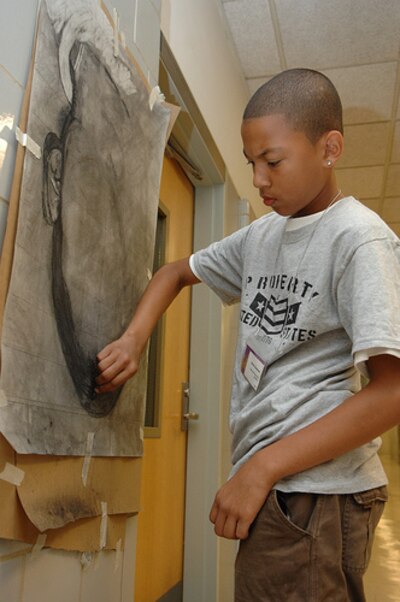Second in a series on free summer opportunities for New York City students. Read the first post about the Manhattan School of Music Summer Music Camp.
On a recent July morning, in a classroom at Stuyvesant High School in Manhattan, master vocal music teacher Jayne Skoog asked her students to pause. “Put your hand here for a minute,” she instructed them, placing her hand on her ribcage. “Put your hand right here.” The students placed their hands over their own chests, studying how air should move in and out of their lungs as they sing.
Down the hall, Joe Bartolozzi was teaching an advanced music theory class, animatedly illustrating a point about tension and release with a joke about a pianist playing “Amazing Grace” and stopping just before the final, resolving chord. Bartolozzi let his students feel that tension as he finished the story – then played the chord, allowing everyone in the room to experience the release firsthand.
Meanwhile, upstairs, students were scattered around teacher Jan Juracek’s photography lab. Two worked together at a computer, using Photoshop to merge a student’s self-portrait with a photograph of the New York City skyline. Juracek sat nearby, helping another student edit a digital photo. A small group sat sprawled at student desks, flipping through photography books and their own portfolios. On the floor, students assembled what appeared to be a poster-sized contact sheet: they explained that it’s a collaborative piece they are creating, bringing together each student’s self-portrait on the theme “THE ARTS: A Lens to the City.”
This theme is shared by the seven studios of the Summer Arts Institute, a free, four-week intensive arts program for New York City public school students entering grades 8-12. In addition to vocal music and photography, the studio programs include instrumental music, dance, drama, visual art, and film.
The approximately 260 students at the Institute study their chosen art form for five hours a day, with an hour-long break at lunchtime. A typical day includes visits from professional artists, trips to local cultural institutions – one highlight this year was a whole-institute trip to see the American Ballet Theatre’s performance of Giselle – studio work, and peer critiques.
Special events include a weekly “SAI Cafe” where students can perform or display works-in-progress, as well as workshops for parents and students on next steps in their education or career. Middle school workshops focus on the process of applying to arts high schools, while high school workshops include panelists from colleges, universities, and conservatory programs.
The Summer Arts Institute was started in 2002, Joan Finkelstein, the DOE’s Director of Dance Programs said. “It was a response to 9/11 and the strong reactions of lower Manhattan students, to give them an intensive arts experience, the opportunity to fully express themselves,” she said.
Juracek, who has been teaching photography at SAI since 2002, said she enjoys teaching at the Institute because of the highly motivated students. In addition, she said, teachers don’t have to worry about having enough supplies or trying to fit art classes into a prescribed lesson format, frustrations they may face during the regular school year. “You have the freedom of really teaching art like you should teach it,” she said.
The students are chosen through an application process that begins in January. Applications include a teacher recommendation and a short essay; auditions are held in April. Finkelstein said that each studio weights the various aspects of the application differently, some emphasizing skill level while others look for students most passionate or interested in the medium.

“These students are really professional,” said Christine Mendoza, a teaching artist from the Tribeca Film Institute who works with the students in the film studio. “They look not only to teachers but to each other for feedback.”
Other teachers agreed, pointing to the Institute’s intensive focus on technical skills in addition to creative expression. Middle school visual arts students were learning a trace-and-transfer drawing technique while also learning about perspective; film students rotate through the different roles on a film crew; dancers create original choreography and study classical ballet technique.
“What they are doing is making points of theory concrete for the kids,” Finkelstein said.
Students agreed the program is quite rigorous. John Walsh, who will start his freshman year at LaGuardia High School of Music & Arts and Performing Arts this fall, believes that he will have an advantage thanks to his vocal music program at the Institute. “I’ll have more knowledge of theory of music than most of the kids coming in.”
“I’m going to be more into photography than I was because now I know what I’m doing,” said Michelle Gavora, a rising 12th grader at Francis Lewis High School. “It’s an awesome program.”
